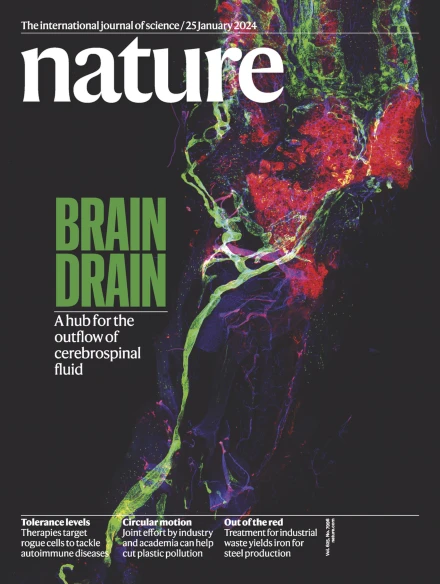Intragrain 3D perovskite heterostructure for high-performance pure-red perovskite LEDs
IF 50.5
1区 综合性期刊
Q1 MULTIDISCIPLINARY SCIENCES
引用次数: 0
Abstract
Metal-halide perovskites are promising light-emitter candidates for next-generation light-emitting diodes (LEDs)1–8. Achieving high brightness and efficiency simultaneously in pure-red perovskite LEDs (PeLEDs) is an ongoing goal9,10. Three-dimensional (3D) CsPbI3-xBrx emitters have excellent carrier transport capability and high colour purity, which could allow efficient and ultrabright pure-red PeLEDs. However, such devices are prone to efficiency roll-off, resulting in low efficiency and low brightness under high current density. Here, by using electrically excited transient absorption spectroscopy, we discovered the efficiency roll-off was induced by hole leakage. Therefore, we developed a CsPbI3-xBrx intragrain heterostructure containing narrow bandgap emitters and wide bandgap barriers to confine the injected carriers. The wide bandgap barrier was incorporated by introducing strongly bonding molecules into the [PbX6]4− framework to expand the 3D CsPbI3-xBrx lattice. This strategy resulted in bright and efficient pure-red PeLEDs, with a high brightness of 24,600 cd m−2, maximum external quantum efficiency of 24.2% and low efficiency roll-off, maintaining a 10.5% external quantum efficiency at a high luminance of 22,670 cd m−2. To increase the efficiency, brightness and stability of next-generation light-emitting diodes (LEDs), the microstructure of CsPbI3-xBrx metal-halide perovskite, a good pure-red emitter, was altered to fix hole leakage, which was identified as decreasing efficiencies in overworked LEDs.

用于高性能纯红色钙钛矿led的三维钙钛矿异质结构
金属卤化物钙钛矿是下一代发光二极管(led) 1-8的有前途的发光候选材料。在纯红色钙钛矿led (pled)中同时实现高亮度和高效率是一个持续的目标9,10。三维(3D) CsPbI3-xBrx发射体具有出色的载流子传输能力和高颜色纯度,可以实现高效和超亮的纯红色pled。然而,这种器件容易出现效率滚降,导致在高电流密度下效率低、亮度低。本文利用电激发瞬态吸收光谱法,发现了由空穴泄漏引起的效率滚降。因此,我们开发了CsPbI3-xBrx晶间异质结构,包含窄带隙发射体和宽带隙势垒来限制注入的载流子。通过在[PbX6]4−框架中引入强键合分子来扩展三维CsPbI3-xBrx晶格,从而结合了宽带隙势垒。该策略产生了明亮高效的纯红色pled,具有24,600 cd m−2的高亮度,24.2%的最大外量子效率和低效率滚降,在22,670 cd m−2的高亮度下保持10.5%的外量子效率。为了提高下一代发光二极管(led)的效率、亮度和稳定性,研究人员改变了CsPbI3-xBrx金属卤化物钙钛矿(CsPbI3-xBrx金属卤化物钙钛矿)的微观结构,以固定孔泄漏,这是一种良好的纯红色发射器,被认为是导致过度工作led效率下降的原因。
本文章由计算机程序翻译,如有差异,请以英文原文为准。
求助全文
约1分钟内获得全文
求助全文
来源期刊

Nature
综合性期刊-综合性期刊
CiteScore
90.00
自引率
1.20%
发文量
3652
审稿时长
3 months
期刊介绍:
Nature is a prestigious international journal that publishes peer-reviewed research in various scientific and technological fields. The selection of articles is based on criteria such as originality, importance, interdisciplinary relevance, timeliness, accessibility, elegance, and surprising conclusions. In addition to showcasing significant scientific advances, Nature delivers rapid, authoritative, insightful news, and interpretation of current and upcoming trends impacting science, scientists, and the broader public. The journal serves a dual purpose: firstly, to promptly share noteworthy scientific advances and foster discussions among scientists, and secondly, to ensure the swift dissemination of scientific results globally, emphasizing their significance for knowledge, culture, and daily life.
 求助内容:
求助内容: 应助结果提醒方式:
应助结果提醒方式:


